Monitoring Injected CO2 Using Earthquake Waves Measured by Downhole Fibre-Optic Sensors: CO2CRC Otway Stage 3 Case Study
Abstract
1. Introduction
2. Theory
3. Experiment Design
4. Data Analysis Workflow
4.1. Event Detection
- Detect all events around the time corresponding to the injection using a modified short time average over long time average (STA/LTA) algorithm [28].
- Manually sort these events and pick travel time curves for P and S waves for several target events.
- Scan the entire dataset using a semblance-based algorithm similar to the one applied to the pilot data acquired in CRC-3 ahead of drilling the most recent Otway wells (2018–2019) [27] using one pair of travel time curves per well representing regional earthquakes as obtained in the previous step.
- Well: CRC-3 and CRC-4, all traces below 200 m,
- Date start: 01/12/2020,
- Date end: 18/2/2021 (CRC-4); 16/03/2021 (CRC-3),
- STA window: 64 ms,
- LTA window: 800 ms,
- STA/LTA detection threshold: 60 (for a sum of STA/LTA ratios for all channels, ~300).
- Semblance calculation time window: 30 ms,
- Combined weighted semblance (70% for P-wave and 30% for S-wave) threshold: 0.3,
- Minimal event separation: 30 s,
- Bandpass filter: Ormsby, 10–20–100–240 Hz.
4.2. Event Location
4.3. Amplitude Analysis
5. CO2 Plume Detection Results
6. Discussion
7. Conclusions
Author Contributions
Funding
Institutional Review Board Statement
Informed Consent Statement
Data Availability Statement
Acknowledgments
Conflicts of Interest
References
- Mateeva, A.; Lopez, J.; Chalenski, D.; Tatanova, M.; Zwartjes, P.; Yang, Z.; Bakku, S.; de Vos, K.; Potters, H. 4D DAS VSP as a tool for frequent seismic monitoring in deep water. Lead. Edge 2017, 36, 995–1000. [Google Scholar] [CrossRef]
- Hornman, J.C.; Mateeva, A.; Potters, J.H.H.M.; Lopez, J.L. New Concepts for lowering the Cost of frequent seismic Reservoir monitoring onshore. In SEG Technical Program Expanded Abstracts 2015; OnePetro: Richardson, TX, USA, 2015; pp. 5518–5522. [Google Scholar]
- Pevzner, R.; Urosevic, M.; Tertyshnikov, K.; AlNasser, H.; Caspari, E.; Correa, J.; Daley, T.; Dance, T.; Freifeld, B.; Glubokovskikh, S.; et al. Chapter 6.1—Active surface and borehole seismic monitoring of a small supercritical CO2 injection into the subsurface: Experience from the CO2CRC Otway Project. In Active Geophysical Monitoring (Second Edition); Kasahara, J., Zhdanov, M.S., Mikada, H., Eds.; Elsevier: Amsterdam, The Netherlands, 2020; pp. 497–522. [Google Scholar]
- Burnison, S.A.; Livers, A.J.; Hamling, J.A.; Salako, O.; Gorecki, C.D. Design and Implementation of a Scalable, Automated, Semi-permanent Seismic Array for Detecting CO2 Extent During Geologic CO2 Injection. Energy Procedia 2017, 114, 3879–3888. [Google Scholar] [CrossRef]
- Andersen, J.K. Automated High Power Permanent Borehole Seismic Source Systems for Long-Term Monitoring of Subsurface CO2 Containment and Storage; DOE-GPUSA-0028748 United States 10.2172/1498640 NETL English; GPUSA Inc.: Los Angeles, CA, USA, 2019. [Google Scholar]
- Correa, J.; Isaenkov, R.; Yavuz, S.; Yurikov, A.; Tertyshnikov, K.; Wood, T.; Freifeld, B.; Pevzner, R. DAS/SOV: Rotary seismic sources with fiber-optic sensing facilitates autonomous permanent reservoir monitoring. Geophysics 2021, 86, 61–68. [Google Scholar] [CrossRef]
- Pevzner, R.; Isaenkov, R.; Yavuz, S.; Yurikov, A.; Tertyshnikov, K.; Shashkin, P.; Gurevich, B.; Correa, J.; Glubokovskikh, S.; Wood, T.; et al. Seismic monitoring of a small CO2 injection using a multi-well DAS array: Operations and initial results of Stage 3 of the CO2CRC Otway project. Int. J. Greenh. Gas Control 2021, 110, 103437. [Google Scholar] [CrossRef]
- Shulakova, V.; Tertyshnikov, K.; Pevzner, R.; Kovalyshen, Y.; Gurevich, B. Ambient seismic noise in an urban environment: Case study using downhole distributed acoustic sensors at the Curtin University campus in Perth, Western Australia. Explor. Geophys. 2022, 1–14. [Google Scholar] [CrossRef]
- Sidenko, E.; Tertyshnikov, K.; Gurevich, B.; Isaenkov, R.; Ricard, L.P.; Sharma, S.; Gent, D.V.; Pevzner, R. Distributed fiber-optic sensing transforms an abandoned well into a permanent geophysical monitoring array: A case study from Australian South West. Lead. Edge 2022, 41, 140–148. [Google Scholar] [CrossRef]
- Glubokovskikh, S.; Pevzner, R.; Sidenko, E.; Tertyshnikov, K.; Gurevich, B.; Shatalin, S.; Slunyaev, A.; Pelinovsky, E. Downhole Distributed Acoustic Sensing Provides Insights Into the Structure of Short-Period Ocean-Generated Seismic Wavefield. J. Geophys. Res. Solid Earth 2021, 126, e2020JB021463. [Google Scholar] [CrossRef]
- Shapiro, S.A. Fluid-Induced Seismicity; Cambridge University Press: Cambridge, UK, 2015. [Google Scholar]
- Glubokovskikh, S.; Saygin, E.; Shapiro, S.; Gurevich, B.; Isaenkov, R.; Lumley, D.; Nakata, R.; Drew, J.; Pevzner, R. A Small CO2 Leakage May Induce Seismicity on a Sub-Seismic Fault in a Good-Porosity Clastic Saline Aquifer. Geophys. Res. Lett. 2022, 49, e2022GL098062. [Google Scholar] [CrossRef]
- Williams-Stroud, S.; Bauer, R.; Leetaru, H.; Oye, V.; Stanek, F.; Greenberg, S.; Langet, N. Analysis of Microseismicity and Reactivated Fault Size to Assess the Potential for Felt Events by CO2 Injection in the Illinois Basin. Bull. Seismol. Soc. Am. 2020, 110, 2188–2204. [Google Scholar] [CrossRef]
- Goertz-Allmann, B.; Dando, B.; Langet, N.; Dichiarante, A.M.; Kühn, D.; Oye, V.; Jordan, M.; Williams-Stroud, S.; Bauer, R.A.; Greenberg, S.E. Long-term Seismic Monitoring of Reservoir Dynamics at Decatur. In Proceedings of the 15th Greenhouse Gas Control Technologies Conference, Online, 15–18 March 2021. [Google Scholar]
- Harvey, S.; O’Brien, S.; Minisini, S.; Oates, S.; Braim, M. Quest CCS Facility: Microseismic System Monitoring and Observations. In Proceedings of the 15th Greenhouse Gas Control Technologies Conference, Online, 15–18 March 2021. [Google Scholar]
- Aki, K. Analysis of the seismic coda of local earthquakes as scattered waves. J. Geophys. Res. 1969, 74, 615–631. [Google Scholar] [CrossRef]
- Curtis, A.; Gerstoft, P.; Sato, H.; Snieder, R.; Wapenaar, K. Seismic interferometry—Turning noise into signal. Lead. Edge 2006, 25, 1082–1092. [Google Scholar] [CrossRef]
- Claerbout, J.F. Synthesis of a layered medium from its acoustic transmission response. Geophysics 1968, 33, 264–269. [Google Scholar] [CrossRef]
- Lobkis, O.I.; Weaver, R.L. On the emergence of the Green’s function in the correlations of a diffuse field. J. Acoust. Soc. Am. 2001, 110, 3011–3017. [Google Scholar] [CrossRef]
- Shapiro, N.M.; Campillo, M.; Stehly, L.; Ritzwoller, M.H. High-Resolution Surface-Wave Tomography from Ambient Seismic Noise. Science 2005, 307, 1615–1618. [Google Scholar] [CrossRef] [PubMed]
- Mateeva, A.; Zwartjes, P.M. Depth Calibration of DAS VSP Channels: A New Data-Driven Method. In Proceedings of the 79th EAGE Conference and Exhibition 2017, Paris, France, 12–15 June 2017; pp. 1–5. [Google Scholar]
- Kazei, V.; Osypov, K.; Alfataierge, E.; Bakulin, A. Amplitude-based DAS logging: Turning DAS VSP amplitudes into subsurface elastic properties. In First International Meeting for Applied Geoscience & Energy Expanded Abstracts; Society of Exploration Geophysicists: Houston, TX, USA, 2021; pp. 412–416. [Google Scholar]
- Pevzner, R.; Gurevich, B.; Pirogova, A.; Tertyshnikov, K.; Glubokovskikh, S. Repeat well logging using earthquake wave amplitudes measured by distributed acoustic sensors. Lead. Edge 2020, 39, 513–517. [Google Scholar] [CrossRef]
- Kazei, V.; Osypov, K. Inverting distributed acoustic sensing data using energy conservation principles. Interpretation 2021, 9, SJ23–SJ32. [Google Scholar] [CrossRef]
- Pevzner, R.; Glubokovskikh, S.; Isaenkov, R.; Shashkin, P.; Tertyshnikov, K.; Yavuz, S.; Gurevich, B.; Correa, J.; Wood, T.; Freifeld, B. Monitoring subsurface changes by tracking direct-wave amplitudes and traveltimes in continuous distributed acoustic sensor VSP data. Geophysics 2022, 87, A1–A6. [Google Scholar] [CrossRef]
- AWI Helmholtz-Zentrum für Polar- und Meeresforschung. Refraction Seismology—AWI. Available online: https://www.awi.de/en/science/geosciences/geophysics/methods-and-tools/refraction-seismology.html (accessed on 7 October 2022).
- Pevzner, R.; Glubokovskikh, S.; Tertyshnikov, K.; Yavuz, S.; Egorov, A.; Sidenko, E.; Popik, S.; Ricard, L.; Correa, J.; Wood, T.; et al. Permanent downhole seismic monitoring for CO2 geosequestration: Stage 3 of the CO2CRC Otway project. In Proceedings of the APGCE 2019, Kuala Lumpur, Malaysia, 29–30 October 2019; Volume 2019, pp. 1–5. [Google Scholar]
- Allen, R.V. Automatic Earthquake Recognition and Timing from Single Traces. Bull. Seismol. Soc. Am. 1978, 68, 1521–1532. [Google Scholar] [CrossRef]
- GA Earthquakes@GA. Available online: https://earthquakes.ga.gov.au/ (accessed on 1 January 2022).
- Earthresources.vic.gov.au Ground Vibration and Airblast Limits for Mines and Quarries—Earth Resources. Available online: https://earthresources.vic.gov.au/legislation-and-regulations/guidelines-and-codes-of-practice/ground-vibration-and-airblast-limits (accessed on 1 January 2022).
- Sidenko, E.; Tertyshnikov, K.; Lebedev, M.; Pevzner, R. Experimental study of temperature change effect on distributed acoustic sensing continuous measurements. Geophysics 2022, 87, D111–D122. [Google Scholar] [CrossRef]
- Pevzner, R.; Tertyshnikov, K.; Sidenko, E.; Glubokovskikh, S.; Gurevich, B. Trialling Passive Seismic with DAS in CO2CRC Otway Project: Ambient Noise Composition and Prospects for Utilisation. In Proceedings of the 82nd EAGE Annual Conference & Exhibition, Online, 18–21 October 2021; European Association of Geoscientists & Engineers: Amsterdam, The Netherlands, 2020. [Google Scholar]
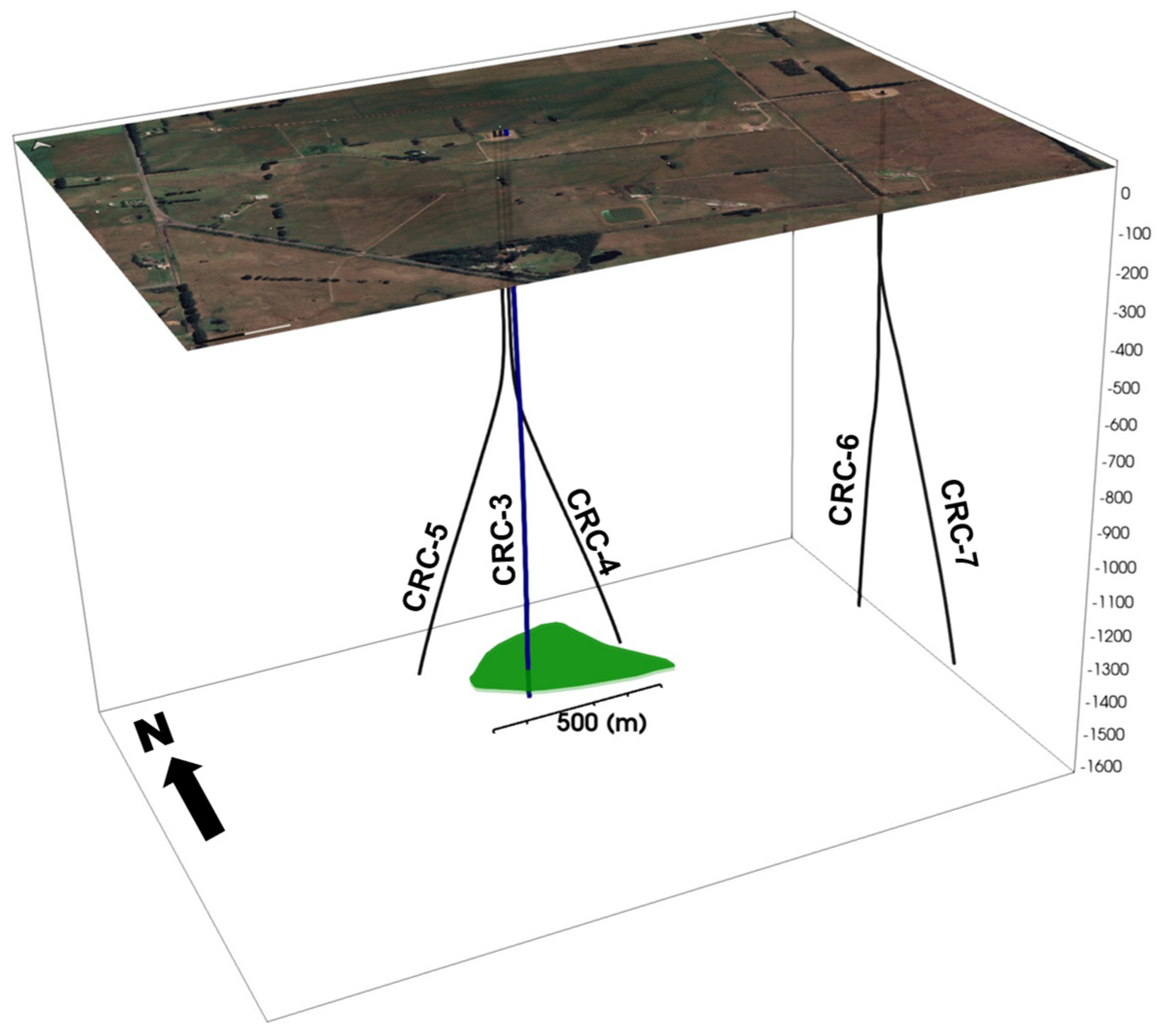
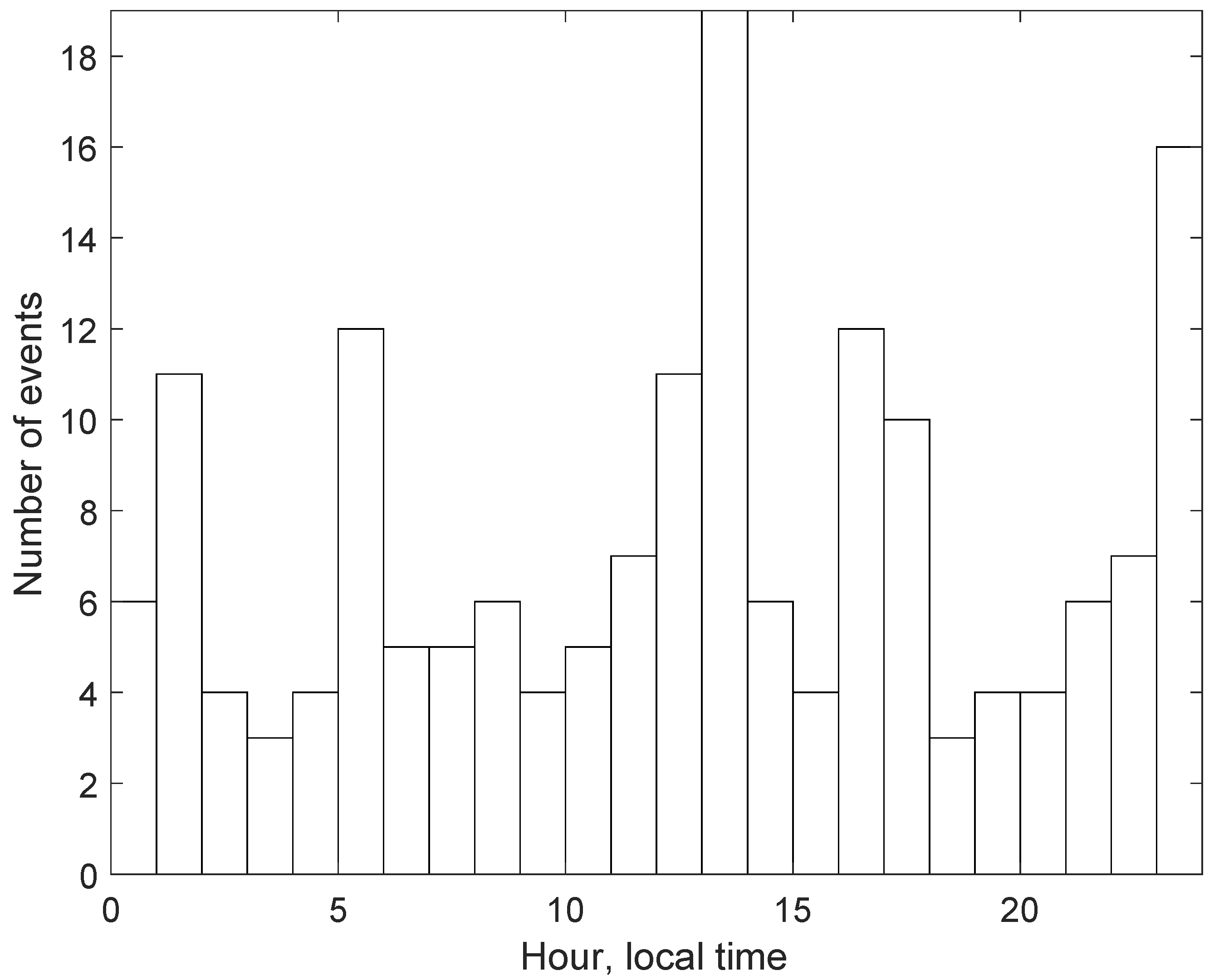

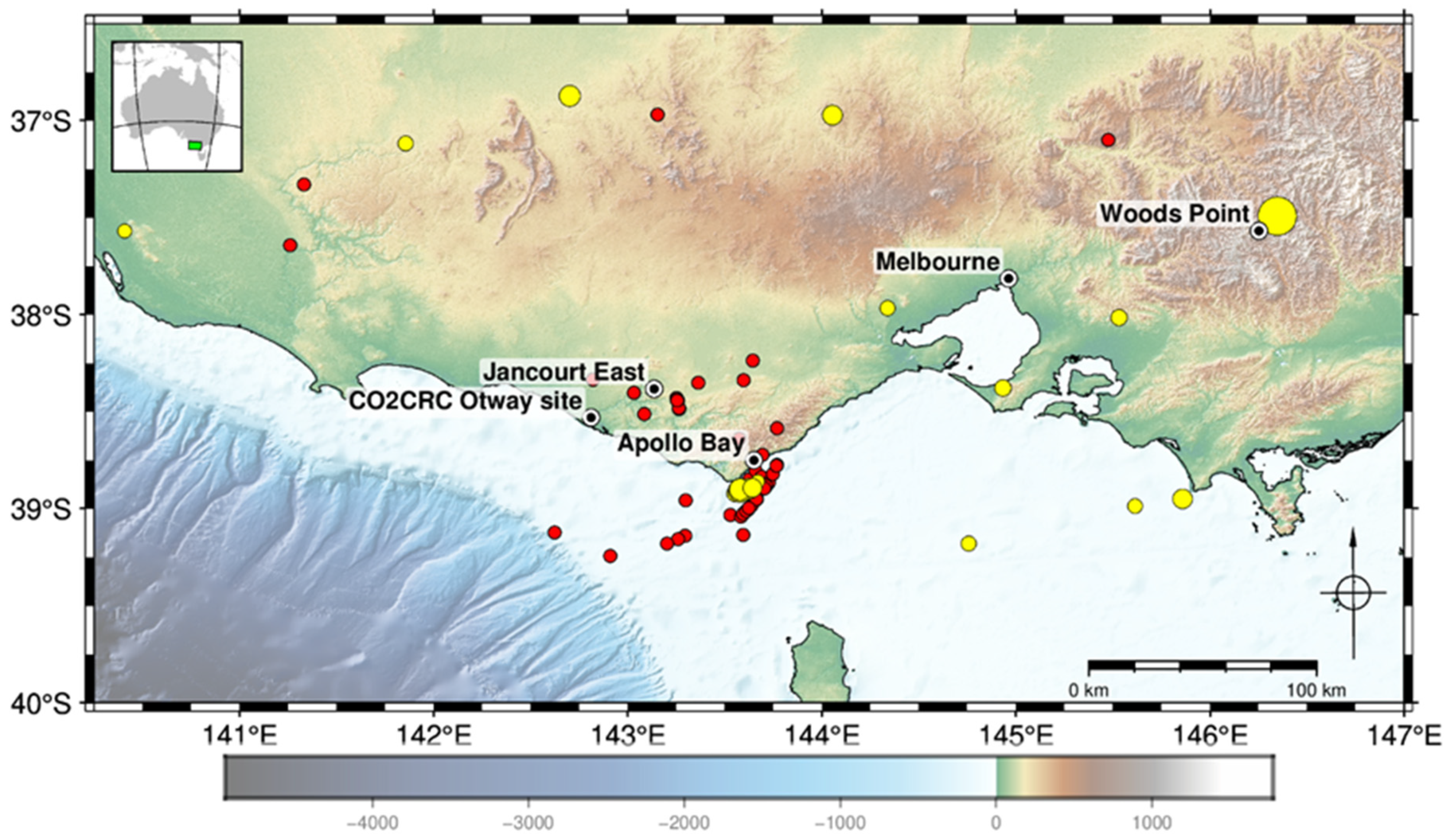
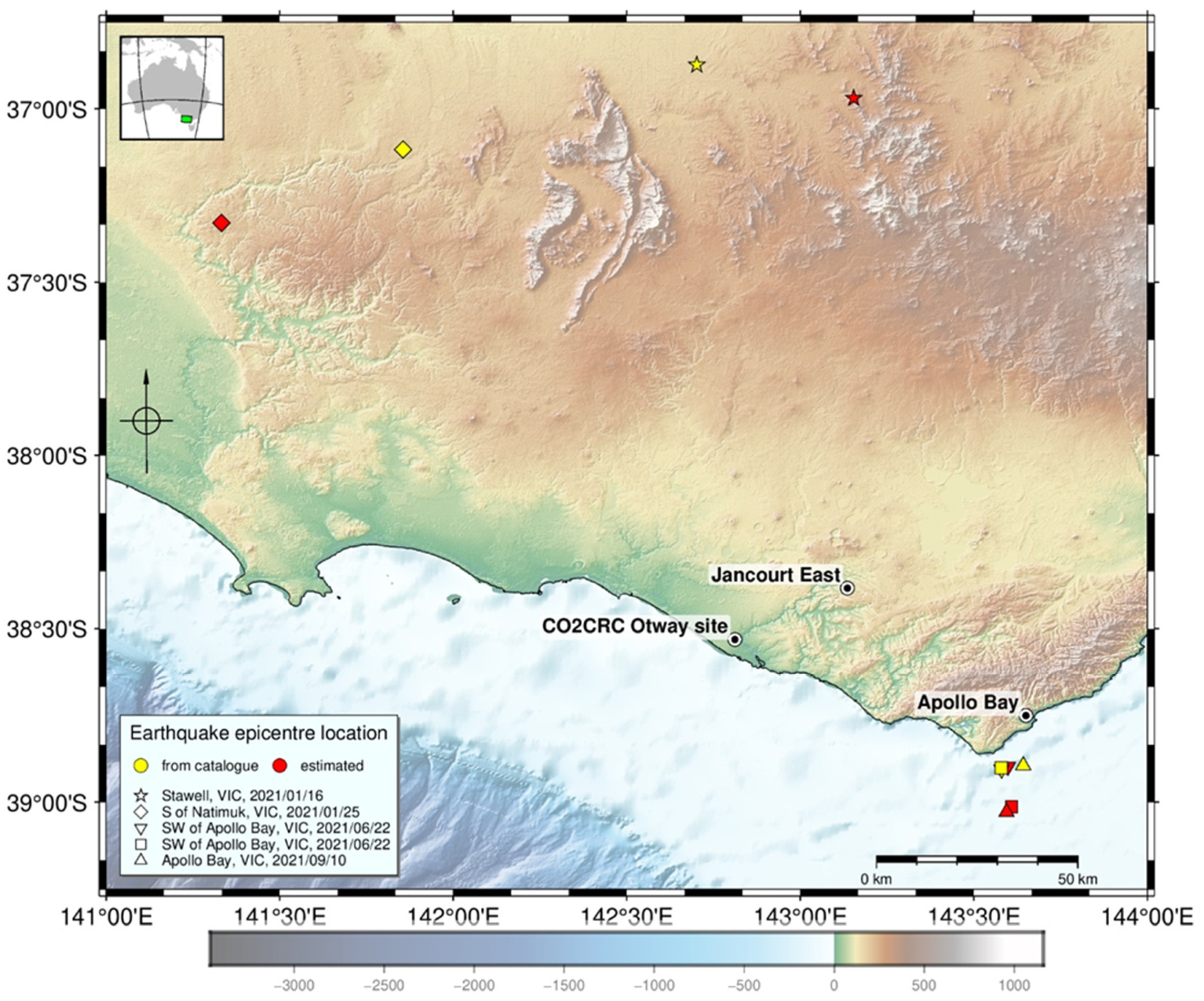

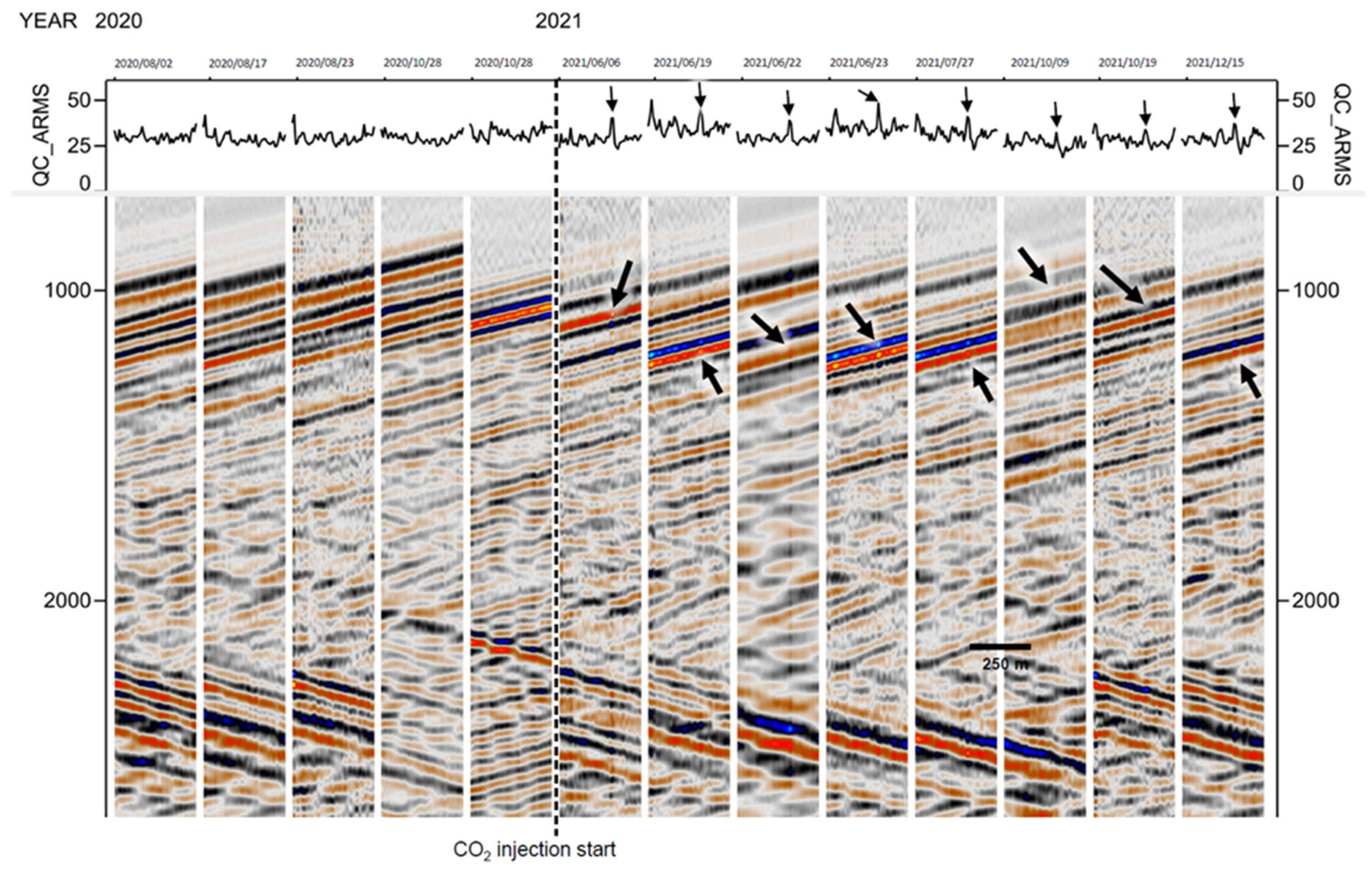

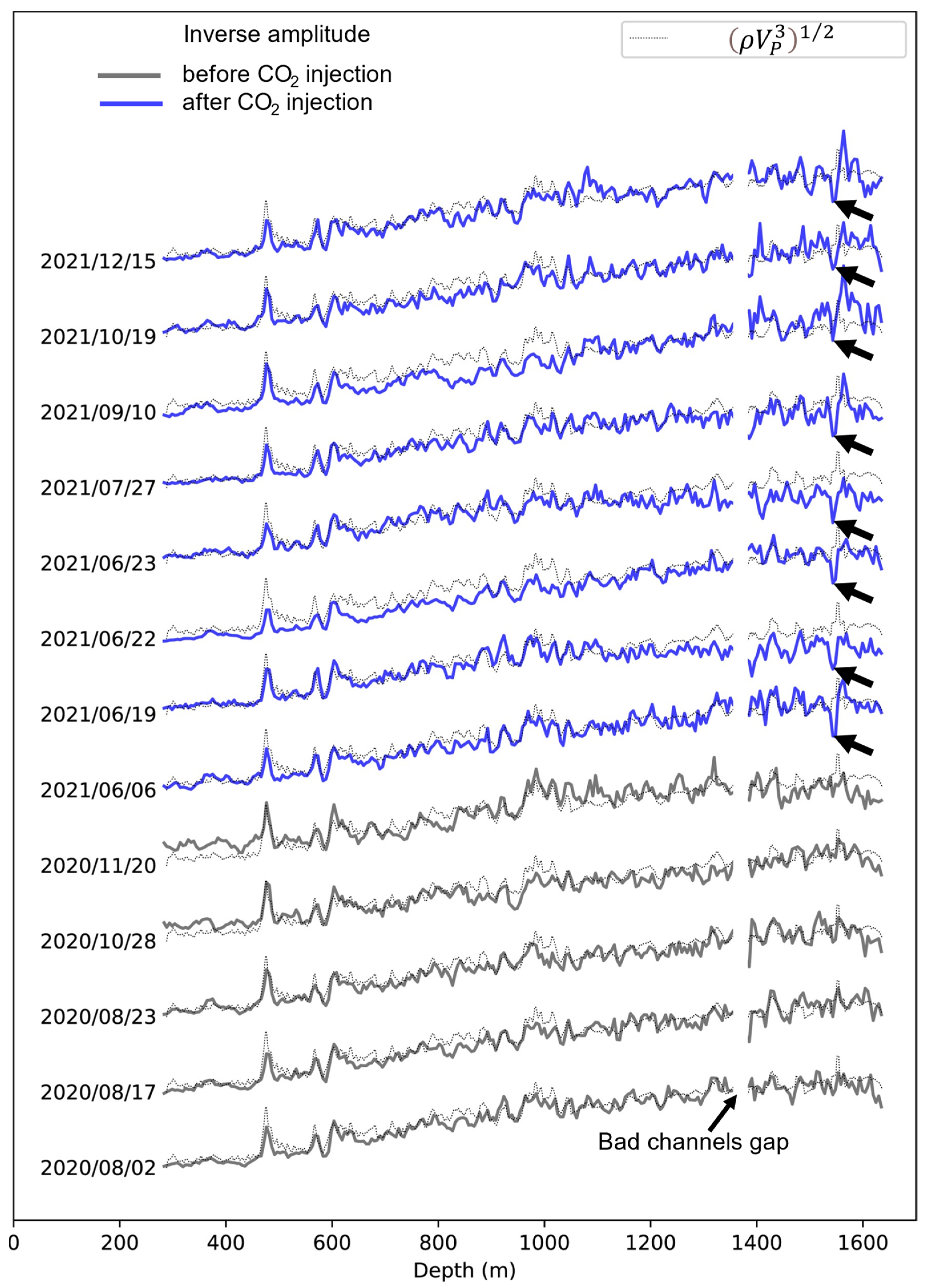
| Travel Time for P Wave (s) | Difference between P and S Wave Arrival Times (s) | Distance from Site (km) | Epicentre Location |
|---|---|---|---|
| 14.0 | 10.0 | 79.23 | Offshore SW of Apollo Bay, VIC, plume visible |
| 14.5 | 10.9 | 78.35 | Apollo Bay, VIC |
| 13.8 | 10.9 | 81.92 | Apollo Bay, VIC (high SNR) |
| 14.0 | 11.0 | 78.86 | Offshore SW of Apollo Bay, VIC |
| 13.2 | 11.0 | 83.24 | Apollo Bay, VIC |
| 13.5 | 11.1 | 83.65 | Apollo Bay, VIC |
| 24.0 | 20.0 | 147.78 | N of Geelong, VIC |
| 28.5 | 22.0 | 184.29 | Stawell, VIC |
| 26.3 | 23.3 | 177.69 | S of Natimuk, VIC |
| 28.9 | 25.0 | 183.94 | Bass Strait |
| 31.5 | 27.6 | 218.31 | Coastal King Island, Offshore TAS |
| 40.7 | 28.0 | 282.57 | Offshore SW of Beachport, SA |
| 40.6 | 31.0 | 269.02 | Offshore Sandy Point, VIC |
| 33.8 | 32.7 | 235.47 | Millicent, SA |
| 38.9 | 34.3 | 261.62 | Wedderburn, VIC |
Publisher’s Note: MDPI stays neutral with regard to jurisdictional claims in published maps and institutional affiliations. |
© 2022 by the authors. Licensee MDPI, Basel, Switzerland. This article is an open access article distributed under the terms and conditions of the Creative Commons Attribution (CC BY) license (https://creativecommons.org/licenses/by/4.0/).
Share and Cite
Shashkin, P.; Gurevich, B.; Yavuz, S.; Glubokovskikh, S.; Pevzner, R. Monitoring Injected CO2 Using Earthquake Waves Measured by Downhole Fibre-Optic Sensors: CO2CRC Otway Stage 3 Case Study. Sensors 2022, 22, 7863. https://doi.org/10.3390/s22207863
Shashkin P, Gurevich B, Yavuz S, Glubokovskikh S, Pevzner R. Monitoring Injected CO2 Using Earthquake Waves Measured by Downhole Fibre-Optic Sensors: CO2CRC Otway Stage 3 Case Study. Sensors. 2022; 22(20):7863. https://doi.org/10.3390/s22207863
Chicago/Turabian StyleShashkin, Pavel, Boris Gurevich, Sinem Yavuz, Stanislav Glubokovskikh, and Roman Pevzner. 2022. "Monitoring Injected CO2 Using Earthquake Waves Measured by Downhole Fibre-Optic Sensors: CO2CRC Otway Stage 3 Case Study" Sensors 22, no. 20: 7863. https://doi.org/10.3390/s22207863
APA StyleShashkin, P., Gurevich, B., Yavuz, S., Glubokovskikh, S., & Pevzner, R. (2022). Monitoring Injected CO2 Using Earthquake Waves Measured by Downhole Fibre-Optic Sensors: CO2CRC Otway Stage 3 Case Study. Sensors, 22(20), 7863. https://doi.org/10.3390/s22207863






